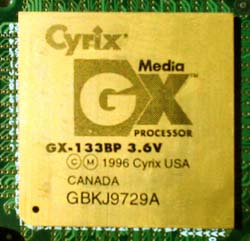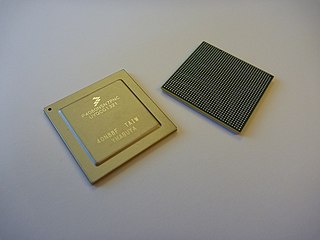Related Research Articles

Itanium is a discontinued family of 64-bit Intel microprocessors that implement the Intel Itanium architecture. The Itanium architecture originated at Hewlett-Packard (HP), and was later jointly developed by HP and Intel. Launched in June 2001, Intel initially marketed the processors for enterprise servers and high-performance computing systems. In the concept phase, engineers said "we could run circles around PowerPC, that we could kill the x86." Early predictions were that IA-64 would expand to the lower-end servers, supplanting Xeon, and eventually penetrate into the personal computers, eventually to supplant RISC and complex instruction set computing (CISC) architectures for all general-purpose applications.
The Intel i860 is a RISC microprocessor design introduced by Intel in 1989. It is one of Intel's first attempts at an entirely new, high-end instruction set architecture since the failed Intel iAPX 432 from the beginning of the 1980s. It was the world's first million-transistor chip. It was released with considerable fanfare, slightly obscuring the earlier Intel i960, which was successful in some niches of embedded systems. The i860 never achieved commercial success and the project was terminated in the mid-1990s.
XScale is a microarchitecture for central processing units initially designed by Intel implementing the ARM architecture instruction set. XScale comprises several distinct families: IXP, IXC, IOP, PXA and CE, with some later models designed as system-on-a-chip (SoC). Intel sold the PXA family to Marvell Technology Group in June 2006. Marvell then extended the brand to include processors with other microarchitectures, like ARM's Cortex.

The Emotion Engine is a central processing unit developed and manufactured by Sony Computer Entertainment and Toshiba for use in the PlayStation 2 video game console. It was also used in early PlayStation 3 models sold in Japan and North America to provide PlayStation 2 game support. Mass production of the Emotion Engine began in 1999 and ended in late 2012 with the discontinuation of the PlayStation 2.

The MediaGX CPU is an x86-compatible processor that was designed by Cyrix and manufactured by National Semiconductor following the two companies' merger. It was introduced in 1997. The core is based on the integration of the Cyrix Cx5x86 CPU core with hardware to process video and audio output. Following the buyout of Cyrix by National Semiconductor and the sale of the Cyrix name and trademarks to VIA Technologies, the core was developed by National Semiconductor into the Geode line of processors, which was subsequently sold to Advanced Micro Devices.

A multi-core processor is a microprocessor on a single integrated circuit with two or more separate processing units, called cores, each of which reads and executes program instructions. The instructions are ordinary CPU instructions but the single processor can run instructions on separate cores at the same time, increasing overall speed for programs that support multithreading or other parallel computing techniques. Manufacturers typically integrate the cores onto a single integrated circuit die or onto multiple dies in a single chip package. The microprocessors currently used in almost all personal computers are multi-core.

TILE64 is a VLIW ISA multicore processor manufactured by Tilera. It consists of a mesh network of 64 "tiles", where each tile houses a general purpose processor, cache, and a non-blocking router, which the tile uses to communicate with the other tiles on the processor.
Tilera Corporation was a fabless semiconductor company focusing on manycore embedded processor design. The company shipped multiple processors in the TILE64, TILEPro64, and TILE-Gx lines.

TriMedia is a family of very long instruction word media processors from NXP Semiconductors. TriMedia is a Harvard architecture CPU that features many DSP and SIMD operations to efficiently process audio and video data streams. For TriMedia processor optimal performance can be achieved by only programming in C/C++ as opposed to most other VLIW/DSP processors which require assembly language programming to achieve optimal performance. High-level programmability of TriMedia relies on the large uniform register file and the orthogonal instruction set, in which RISC-like operations can be scheduled independently of each other in the VLIW issue slots. Furthermore, TriMedia processors boast advanced caches supporting unaligned accesses without performance penalty, hardware and software data/instruction prefetch, allocate-on-write-miss, as well as collapsed load operations combining a traditional load with a 2-taps filter function. TriMedia development has been supported by various research studies on hardware cache coherency, multithreading and diverse accelerators to build scalable shared memory multiprocessor systems.

Tegra is a system on a chip (SoC) series developed by Nvidia for mobile devices such as smartphones, personal digital assistants, and mobile Internet devices. The Tegra integrates an ARM architecture central processing unit (CPU), graphics processing unit (GPU), northbridge, southbridge, and memory controller onto one package. Early Tegra SoCs are designed as efficient multimedia processors. The Tegra-line evolved to emphasize performance for gaming and machine learning applications without sacrificing power efficiency, before taking a drastic shift in direction towards platforms that provide vehicular automation with the applied "Nvidia Drive" brand name on reference boards and its semiconductors; and with the "Nvidia Jetson" brand name for boards adequate for AI applications within e.g. robots or drones, and for various smart high level automation purposes.

QorIQ is a brand of ARM-based and Power ISA–based communications microprocessors from NXP Semiconductors. It is the evolutionary step from the PowerQUICC platform, and initial products were built around one or more e500mc cores and came in five different product platforms, P1, P2, P3, P4, and P5, segmented by performance and functionality. The platform keeps software compatibility with older PowerPC products such as the PowerQUICC platform. In 2012 Freescale announced ARM-based QorIQ offerings beginning in 2013.
Manycore processors are special kinds of multi-core processors designed for a high degree of parallel processing, containing numerous simpler, independent processor cores. Manycore processors are used extensively in embedded computers and high-performance computing.
TILEPro64 is a VLIW ISA multicore processor manufactured by Tilera. It consists of a cache-coherent mesh network of 64 "tiles", where each tile houses a general purpose processor, cache, and a non-blocking router, which the tile uses to communicate with the other tiles on the processor.
Tile processors for computer hardware, are multicore or manycore chips that contain one-dimensional, or more commonly, two-dimensional arrays of identical tiles. Each tile comprises a compute unit, caches and a switch. Tiles can be viewed as adding a switch to each core, where a core comprises a compute unit and caches.

POWER8 is a family of superscalar multi-core microprocessors based on the Power ISA, announced in August 2013 at the Hot Chips conference. The designs are available for licensing under the OpenPOWER Foundation, which is the first time for such availability of IBM's highest-end processors.
Project Denver is the codename of a central processing unit designed by Nvidia that implements the ARMv8-A 64/32-bit instruction sets using a combination of simple hardware decoder and software-based binary translation where "Denver's binary translation layer runs in software, at a lower level than the operating system, and stores commonly accessed, already optimized code sequences in a 128 MB cache stored in main memory". Denver is a very wide in-order superscalar pipeline. Its design makes it suitable for integration with other SIPs cores into one die constituting a system on a chip (SoC).
FeiTeng is the name of several computer central processing units designed and produced in China for supercomputing applications. The microprocessors have been developed by Tianjin Phytium Technology. The processors have also been described as the YinHeFeiTeng family. This CPU family has been developed by a team directed by NUDT's Professor Xing Zuocheng.

Fermi is the codename for a graphics processing unit (GPU) microarchitecture developed by Nvidia, first released to retail in April 2010, as the successor to the Tesla microarchitecture. It was the primary microarchitecture used in the GeForce 400 series and GeForce 500 series. It was followed by Kepler, and used alongside Kepler in the GeForce 600 series, GeForce 700 series, and GeForce 800 series, in the latter two only in mobile GPUs. In the workstation market, Fermi found use in the Quadro x000 series, Quadro NVS models, as well as in Nvidia Tesla computing modules. All desktop Fermi GPUs were manufactured in 40nm, mobile Fermi GPUs in 40nm and 28nm. Fermi is the oldest microarchitecture from NVIDIA that received support for the Microsoft's rendering API Direct3D 12 feature_level 11.

MikroTik is a Latvian network equipment manufacturer. The company develops and sells wired and wireless network routers, network switches, access points, as well as operating systems and auxiliary software. The company was founded in 1996, and as of August 2019, the company website reported an estimated 280 employees. In 2021, with a value of EUR 1.24B, Mikrotik was the 3rd largest company in Latvia and the first private company to surpass EUR 1B value in Latvia.
References
- "Tilera Corporation Joins China's Wireless TD Forum as a Senior Member" (Press release). Tilera. 26 October 2009. Archived from the original on 26 July 2011. Retrieved 16 June 2011.
- 1 2 "END OF LIFE NOTIFICATION" (PDF). Nvidia. 11 April 2022. Retrieved 21 May 2023.
- 1 2 "Tilera preps many-cored Gx chips for March launch". 30 January 2012. Retrieved 21 February 2013.
- ↑ "TILE-Gx8009 datasheet" (PDF). Archived from the original (PDF) on 2013-02-01.
- ↑ "TILE-Gx8016 datasheet" (PDF). Archived from the original (PDF) on 2013-02-26.
- ↑ "TILE-Gx8036 datasheet" (PDF). Archived from the original (PDF) on 2013-03-22.
- ↑ "TILE-Gx8072 datasheet" (PDF). Archived from the original (PDF) on 2013-08-16.
- ↑ "TILE-Gx architecture shema". Archived from the original (JPG) on 2013-03-22.
- ↑ "MIT's 100-core CPU Will Be Ready This Year". 24 January 2012. Retrieved 21 February 2013.
- ↑ "Tilera announces 72-core Tile-Gx chip". 19 February 2013. Archived from the original on July 2, 2013. Retrieved 21 February 2013.
{{cite news}}: CS1 maint: unfit URL (link) - ↑ "Linux 4.17 Spring Cleaning To Drop Some Old CPU Architectures". 17 March 2018. Retrieved 21 January 2021.